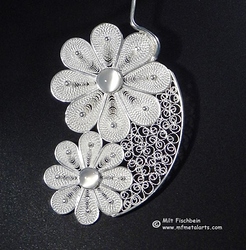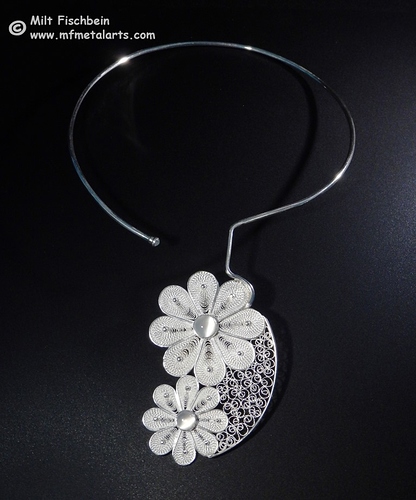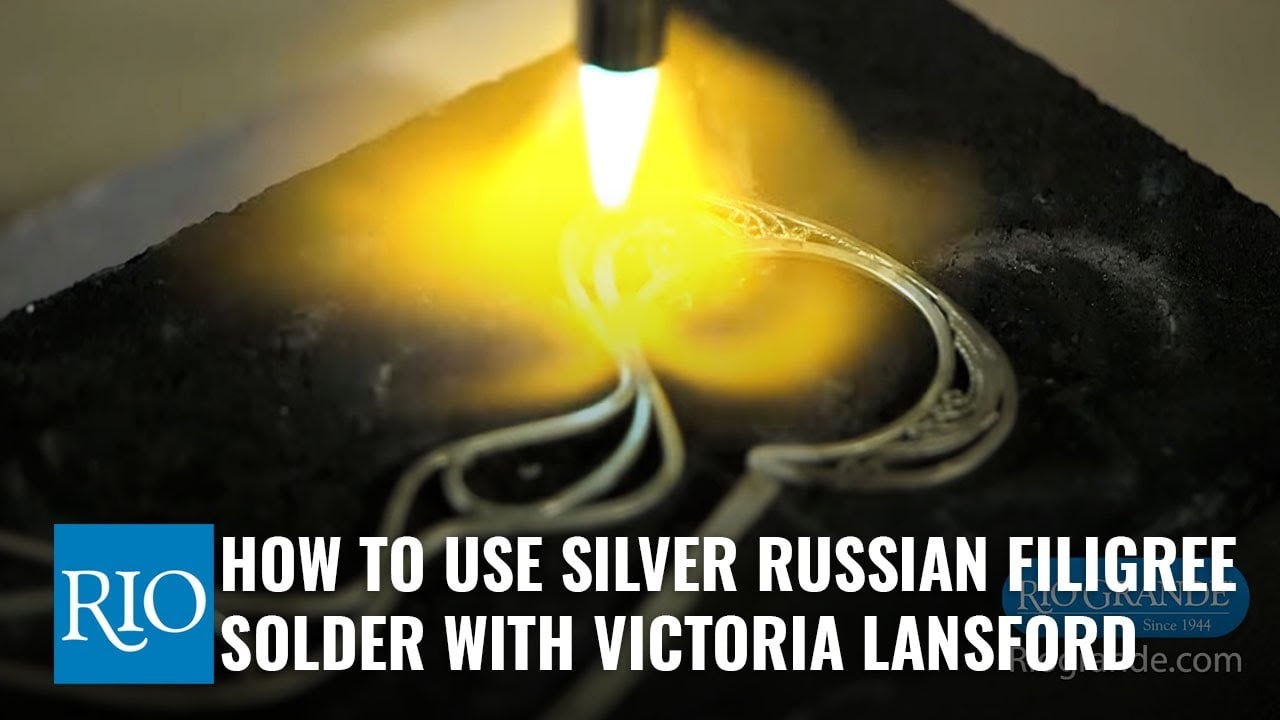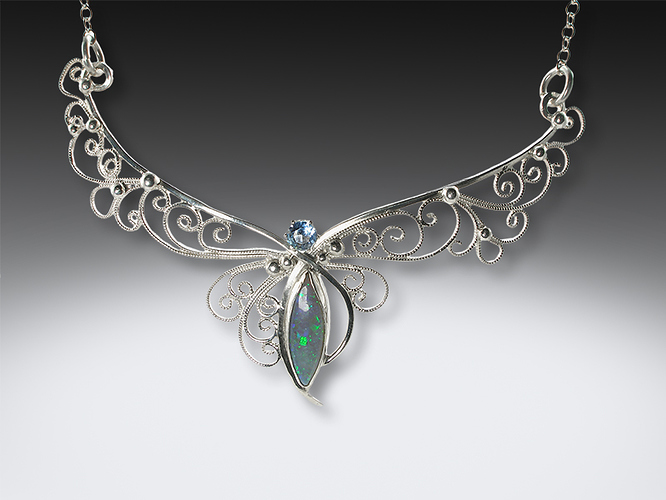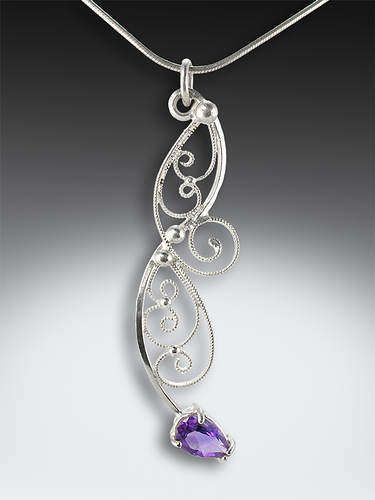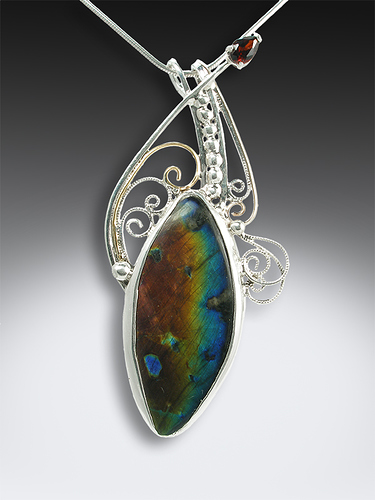I have recently started to experiment with filigree and have had some success. It is also just a lot of fun. Most of my previous work over the last 45 years has been fairly heavy and I am used to a Presto-Lite, Meco and Little Torch. I can make them work for filigree, but would like to find a torch with a smaller bushier flame and have thought some of trying a gas and air blow pipe. Any suggestions on what to buy or make to solder filigree would be appreciated. Thanks…Rob
Hi… Filigree is my specialty! I actually use a hardware,
propane/AIR torch with a hose…the kind you can attach to a 1 lb
can, with a pencil or brush flame… on filigree, you want to be
able to get a larger area of the filigree heated when melting the
solder(I use chip solder, some use powdered-I find paste and wire
solder doesn’t work well as you often end up moving wires apart
trying to apply it, or get too much solder(wire)).
Unfortunately, with the popularity of hand held butane torches,
these propane/air with hose torches are getting hard to find…so
alternatively, try some of the larger butane torches…they will
work. You need to make sure you heat the whole filigree area by
moving the flame in circles around the solder joints…
otherwise, the wire works as a heat sink and draws heat away from
the joint itself. Same thing when you are soldering filigree to a
larger setting…you must heat the setting and filigree
sufficiently to get solder to properly flow. Liquid flux, like
batterns or rio ready flux is good, but mix it out with up to 1/3
denatured alcohol and use a flux bottle(the kind with a metal tube
for precision.) Once you flux your pieces on the board, light the
flux and let it burn off…only takes a couple of seconds but keep
your distance when you light it. The reason for this is that
standard flux, without the alcohol, has a tendency to boil and
push the small filigree pieces apart if they are not tightly
contained in a framework. The alcohol burns off the liquid
quickly, leaving a coating of dry flux without displacing any
wires.
I also often use a soldering pick.. I have a demo of this up on
my youtube https://www.youtube.com/watch?v=QbywQI_mUrY&t=106s
if the link is removed, look for username Jeanniusdesigns on
youtube and filigree demo-higher quality.
the type of base you work on can also be important... charcoal
block, the white solderite pads, or fire brick will work, but the
charcoal tends to degrade faster and once it starts to get uneven,
needs to be replaced or somehow shaved down. DO NOT USE magnesia
soldering blocks! they have a tendency to bubble up and become
uneven quickly.
Hope this helps, feel free to find me on facebook (there are two
profiles, one with a cat…don’t use this one…it’s a backup one
that I rarely check) if you want to get in touch with me directly.
I did have a published book (Silver Threads), but it, along with
all other higher level jewelry books, was discontinued by Kalmbach
in print form. it can be found on ebay or used or in nookbook
e-book format. I’m planning to redo it with updated info and video
etc… eventually. I also have a filigree group on FB where people
can share info and pictures etc… contact me for link
as to blow pipes...that is what I learned on, in Norway, but I
prefer the propane air torches
Jeanne…Thanks! Just what I am looking to hear. I have an EZ Torch, which is propane and air, but it still seems a little harsh. I have wanted a reason to try a small butane torch and this may be it…Rob
Hi Rob,
I use the EZ torch, propane/air for making filigree. (note that I have been creating filigree for about 7 yrs and my studio practice is currently almost 100% filigree. I also regularly teach filigree workshops.)
I have found that oxy/fuel torches are just too hot. When I first started making filigree, I researched torches quite a bit. I found that outside of North America, and particularly in Mexico, central america and South America, the vast majority of filigree artists use the EZ torch, also known as the Orca torch.
I have also had good success with the acetylene/air ie the Prestolite torch, but prefer using propane /air as it runs cooler.
I generally use the medium or the large torch tip. I adjust my flame to be slightly reducing ie i reduce the air mix until the flame looses its shape ie no blue cone, and then slowly add the air back in until the blue cone just begins to form. I find this to be the ideal flame for filigree
As for solder, most filigree artists use powder solder which they generally make themselves, utilizing formulations that have been handed down through generations. I have made my own powder and have used it successfully, but have found making it to be too labour intensive. I have standardized on paste solder which I buy from Rio Grande (Rio #103100)
I have attached a photo of one of my recent pieces to give you an idea of the type of work I produce with the EZ torch and paste solder.
I hope you find this info usefull
Milt, Calgary Canada
DSCN5518%20Crop%20Compr|416x500 )
Milt…Thanks for the great information. I do have an EZ torch that I use for annealing. I have thought about exploring it for filigree but, to date, I haven’t given it a fair try. With your suggested adjustments, I definitely will. I have a container of filigree solder from Rio. I haven’t really gotten it to work, so I touch solder with 20 gauge medium wire solder that I roll out to about .25 mm. Any suggestions on how to make the filigree solder work would be appreciated. Your attachment doesn’t open. My guess it that it is a result of how it is attached. I would love to see your work. Thanks again…Rob
Hi Rob
I have attached two photos to this post. Hopefully I get it right this time and I will answer your solder question in a separate post shortly
Hi Again Rob
I think that the photos uploaded successfully this time. (see my previous post)
You also asked about Rio Grand filigree solder. I assume that you are referencing Victoria Lansford’s Russian Filigree Solder Rio #132209. There is a really good U Tube video that describes how to use this solder. You can find the link on Rio’s website as well as Victoria’s website. I pasted the link for you
Victoria applies her powder solder by dissolving it in water and brushing it on. I demo her solder in my Intro to Filigree workshops.
Victoria’s method for applying powder solder is different from the techniques that I have seen other filigree artists use, but her technique works quite well.
Victoria also has a great DVD on how to make filigree jewellery. You can purchase it directly on her website, where you can get a downloadable version. Victoria’s website is https://victorialansford.com/
When I was first teaching myself filigree, I purchased Victoria’s video and I learned a lot from it. I was also lucky enough to take a workshop from her about 5 years ago. She is an excellent teacher. If you do purchase her DVD, the newest version has a few photos of my Filigree Crown and Tiara in the section on student work.
I hope that this is helpful
Milt
Calgary Canada
Milt…You work is great. After 45 years of banging heavy pieces of silver into heavier cuff bracelets, I decided to look for something less physical to work on. That doesn’t mean I will stop making heavy cuffs. There is something about filigree that has kept me fascinated for months. There is the mental tasks of figuring out how to make frame piece from stock and the start and finish dimensions. How to draw fine filigree wire, to what gauge, how tight to twist and final roll. All this so that the separate pieces go together. I would be interested in your thoughts about all these relative dimensions. Making them from stock or scrap is no problem, I have done that for years. I tried out my EZ torch early this morning and I think that it will help. I can make it produce a wide soft flame that will go a long way towards being able to solder multiple locations at the same time without melting the little ends. I have looked at some of Victoria’s short videos, but I haven’t bought her CD. The solder that I have is hers. Her work is amazing. Thanks for ll your help…Rob
Rob, I have made my stock from scratch in the past, but I now buy all of it to save time. Typical frames start with 16, 18 or 20 Ga round sterling wire, rolled in a mill to a pleasing “oval type” shape. Filigree filler wire is fine silver, pairs of 26 Ga twisted together and flattened in a rolling mill.
Good luck with your journey into making filigree
Milt
Thanks! I looked at your website, I like what you do…Rob
Hi Rob
Thanks for the feedback
My next workshop starts 3 weeks from today and is a week long intensive Introduction to Filigree, at Red Deer College in Alberta Canada
Workshop cost is $600 cad (about $450 US) and accommodations at the college are only $55 Cad (about 40 US) per night.
Last time I checked with the college there were still a couple of spots available
You can find more info at
https://rdc.ab.ca/continuing-education/summer-rdc/series-summer-arts-school
Regards
Milt
Facebook : www.facebook.com/MFMetalArts
Instagram : @mfmetalarts
Milt…I saw this class scheduled on your website. It is tempting, but the summer is booked. Do you get any closer to central NY?..Rob
Not all filigree is done with fine silver. Mine is based in the Norwegian style which is done in sterling or 830(in Norway, not here). Rio made filigree wire when my book came out. If they still carry it, it was order me 100-831. It is sterling, about 1x0.5 mm half hard. Framework, I use around 18 gauge square wire. Using sterling allows a bit more open work to be possible. I will try to attack examples of my work so you can see the difference.
Hi again Rob,
I do not teach in the US as the process for getting a US visa for teaching is onerous.
I currently have workshops scheduled in Alberta which is the province I live in.
I have some plans in the works for eastern Canada, which would be much closer to you.
I always post workshop details in my website and on Instagram as they become available
Regards
Milt
Facebook : www.facebook.com/MFMetalArts
Instagram : @mfmetalarts
Milt…Thanks! I will watch your website. If you have a regular email post, add my to your distribution…Rob
Jeanne…I did make some sterling filler wire and it does behave differently than fine. I should go back and try it again now that I know a little bit more about what I am doing. Thanks…Rob
Hi Jeanne
Yes, I have some experience with using sterling 9925) for the filler wire. A few years ago, I participated in a workshop in Oaxaca Mexico, where we learned traditional Oaxacan filigree. Frames and filler were all made of sterling silver. The instructor, who had been a filigree artist since he was in his teens, had never used fine silver in the making of filigree.
I also occasionally use sterling filler wire, but most of my filigree is done with fine silver. Sterling filigree wire is too springy for me to use in middle eastern style flowers and coils.
Milt
Greetings All,
For the past 21 years, I have worked in 22-karat gold and have never perfected working with fine silver. I now have a new direction and want to make a kinetic, filigree butterfly lapel pin using fine silver.
My question is: What solder do I use on fine silver?
I watched Victoria Lansford’s video above and will purchase the Russian Filigree Powdered Solder from Rio Grande. I don’t think she mentioned whether she was working with sterling or fine silver.
Are there any other options for soldering fine silver?
Thank you. Your help through the years, was, and still is, greatly appreciated.
Kind regards,
Lois
@loisgore22
